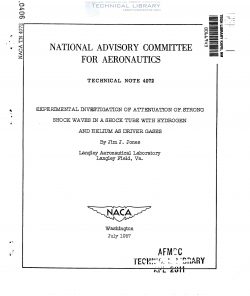naca-tn-4072
- Version
- 134 Downloads
- 856.12 KB File Size
- 1 File Count
- January 31, 2017 Create Date
- January 31, 2017 Last Updated
National Advisory Committee for Aeronautics, Technical Notes - Experimental Investigation of Attenuation of Strong Shock Waves in a Shock Tube with Hydrogen and Helium as Driver Gas

An experimental investigation has been made-of the attenuation of
strong shock waves in air in a shock tube. Time-history measurements
were made of the static pressure at several stations in the wall of the
tube. The internal diameter of the tube is 3.75 inches. Shock-wave-
velocity data were taken for a distance along the tube of about 120 feet.
The range of the shock-wave mach number covered was from 5 to 10% and
the initial pressure ahead of the shock wave varied from 5 to 100 milli-
meters of mercury. Hydrogen and helium were used as driver gases.
A helium-driven shock wave was found to decay only about one-half
as rapidly as a hydrogen-driven shock wave. The pressure level had
little effect on the attenuation rate of a shock wave of given strength
for the pressure range investigated. The static-pressure measurements
indicated that a severe pressure gradient existed in the latter portion
of the air flow. This gradient limits the testing time useful for
obtaining reliable aerodynamic data.
The shock tube has become a practical facility for obtaining aero-
dynamic data in simulation of hypersonic flight. High stagnation-
temperature flows are rather easihy produced in the shock tube, and
high flow Mach numbers may be obtained by expanding the flow through a
nozzle. (See, for example, ref. 1.)
The inherent shortcoming of the shock tube is, of course, the very
short testing time. Some increase in testing time is possible by
increasing the linear dimensions of the tube. However, the tube must
of necessity be long if strong shock waves are considered because the
testing time, the time interval between the arrival of the shock wave
and the contact surface (the term "contact surface" is used throughout
to designate what is in reality a mixing zone between the air and the
driver gas), at any station decreases with increasing shock-wave Mach
number. The increase in testing time obtained by increasing the tube
length is limited because the attenuation of the shock wave is consid-
erable in traveling through a tube which is many diameters long.
| File | Action |
|---|---|
| naca-tn-4072 Experimental Investigation of Attenuation of Strong Shock Waves in a Shock Tube with Hydrogen and Helium as Driver Gas.pdf | Download |

Comment On This Post